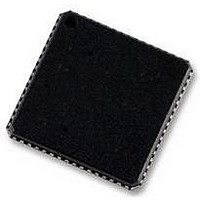AD9248BCP-40EBZ Analog Devices Inc, AD9248BCP-40EBZ Datasheet - Page 17

AD9248BCP-40EBZ
Manufacturer Part Number
AD9248BCP-40EBZ
Description
BOARD EVAL WITH AD9248BCP-40
Manufacturer
Analog Devices Inc
Specifications of AD9248BCP-40EBZ
Number Of Adc's
2
Number Of Bits
14
Sampling Rate (per Second)
40M
Data Interface
Parallel
Inputs Per Adc
1 Differential
Input Range
2 Vpp
Power (typ) @ Conditions
360mW @ 40MSPS
Voltage Supply Source
Single
Operating Temperature
-40°C ~ 85°C
Utilized Ic / Part
AD9248BCP-40
Silicon Manufacturer
Analog Devices
Application Sub Type
ADC
Kit Application Type
Data Converter
Silicon Core Number
AD9248
Kit Contents
Board
Power Dissipation Pd
400mW
Termination Type
SMD
Lead Free Status / RoHS Status
Lead free / RoHS Compliant
Lead Free Status / RoHS Status
Lead free / RoHS Compliant, Lead free / RoHS Compliant
THEORY OF OPERATION
The AD9248 consists of two high performance ADCs that are
based on the AD9235 converter core. The dual ADC paths are
independent, except for a shared internal band gap reference
source, VREF. Each of the ADC paths consists of a proprietary
front end SHA followed by a pipelined switched-capacitor ADC.
The pipelined ADC is divided into three sections, consisting
of a 4-bit first stage, followed by eight 1.5-bit stages, and a final
3-bit flash. Each stage provides sufficient overlap to correct for
flash errors in the preceding stages. The quantized outputs from
each stage are combined through the digital correction logic
block into a final 14-bit result. The pipelined architecture
permits the first stage to operate on a new input sample, while
the remaining stages operate on preceding samples. Sampling
occurs on the rising edge of the
respective clock.
Each stage of the pipeline, excluding the last, consists of a low
resolution flash ADC and a residual multiplier to drive the next
stage of the pipeline. The residual multiplier uses the flash ADC
output to control a switched-capacitor digital-to-analog converter
(DAC) of the same resolution. The DAC output is subtracted from
the stage’s input signal and the residual is amplified (multiplied)
to drive the next pipeline stage. The residual multiplier stage is
also called a multiplying DAC (MDAC). One bit of redundancy
is used in each one of the stages to facilitate digital correction of
flash errors. The last stage simply consists of a flash ADC.
The input stage contains a differential SHA that can be
configured as ac- or dc-coupled in differential or single-ended
modes. The output-staging block aligns the data, carries out the
error correction, and passes the data to the output buffers. The
output buffers are powered from a separate supply, allowing
adjustment of the output voltage swing.
ANALOG INPUT
The analog input to the AD9248 is a differential, switched-
capacitor SHA that has been designed for optimum perfor-
mance while processing a differential input signal. The SHA
input accepts inputs over a wide common-mode range. An
input common-mode voltage of midsupply is recommended
to maintain optimal performance.
The SHA input is a differential switched-capacitor circuit. In
Figure 32, the clock signal alternatively switches the SHA
between sample mode and hold mode. When the SHA is
switched into sample mode, the signal source must be capable
of charging the sample capacitors and settling within one-half
of a clock cycle. A small resistor in series with each input can
help reduce the peak transient current required from the output
stage of the driving source. Also, a small shunt capacitor can be
placed across the inputs to provide dynamic charging currents.
This passive network creates a low-pass filter at the ADC input;
therefore, the precise values are dependent on the application.
Rev. B | Page 17 of 48
In IF under-sampling applications, any shunt capacitors
should be removed. In combination with the driving source
impedance, they limit the input bandwidth. For best dynamic
performance, the source impedances driving VIN+ and VIN−
should be matched such that common-mode settling errors are
symmetrical. These errors are reduced by the common-mode
rejection of the ADC.
An internal differential reference buffer creates positive and
negative reference voltages, REFT and REFB, respectively, that
define the span of the ADC core. The output common mode of
the reference buffer is set to midsupply, and the REFT and
REFB voltages and span are defined as:
The equations above show that the REFT and REFB voltages are
symmetrical about the midsupply voltage and, by definition, the
input span is twice the value of the V
The internal voltage reference can be pin-strapped to fixed values
of 0.5 V or 1.0 V or adjusted within the same range as discussed
in the Internal Reference Connection section. Maximum SNR
performance is achieved with the AD9248 set to the largest
input span of 2 V p-p. The relative SNR degradation is 3 dB
when changing from 2 V p-p mode to 1 V p-p mode.
The SHA may be driven from a source that keeps the signal
peaks within the allowable range for the selected reference
voltage. The minimum and maximum common-mode input
levels are defined as:
VIN+
VIN–
REFT = ½(AVDD + V
REFB = ½(AVDD −V
Span = 2 × (REFT − REFB) = 2 × V
VCM
VCM
C
C
PAR
MIN
MAX
PAR
= V
= (AVDD + V
Figure 32. Switched-Capacitor Input
REF
T
T
/2
REF
REF
REF
5pF
5pF
)
)
)/2
REF
T
T
voltage.
REF
H
H
AD9248














